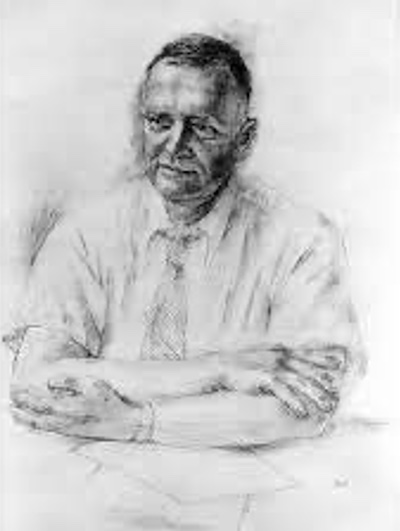Noted author spun many ‘yarns and folktales’ about growing up in Albion
By Catherine Cooper, Orleans County Historian
“Illuminating Orleans” – Vol. 3, No. 34

National Portrait Gallery image of Carl Carmer (1893-1976), Class of 1910, Albion.
ALBION – “Albion is a boom town now, alert, progressive, dynamic. It is about the same size as it was forty years ago, but it believes in growth as it never did then, and it will grow. It has a local ‘Committee of Economic Development’ which was sponsored by the Albion Chamber of Commerce and that committee has worked hard and with intelligence and foresight.”
This was Carl Carmer’s optimistic observation following a visit to his hometown in the 1940s after an absence of 40 years. At the time of this return visit, he was nationally recognized as an accomplished author and folklorist. His first book “Stars Fell on Alabama,” published in 1934 was a bestseller and Literary Guild Selection. He told American folktales on a CBS radio show called Your Neck O’ the Woods.
He described this trip to Albion in the chapter “Hometown Revisited” which is included in his book “Dark Trees to the Wind” published in 1949. He referenced as sources, Charles D’Amico, principal of Albion High School, and Joseph B. Achilles, Orleans County historian. What lively conversations they must have had!
Carmer graduated from Albion in 1910 and then pursued studies in English literature at Hamilton and Harvard. He had happy memories of growing up in Albion in the early 1900s –learning to swim in a swift-running culvert, jumping to the decks of slow canal boats on one bridge and climbing back at the next, bicycling nine miles to Oak Orchard to swim.
He recalled an era when:
“Albion was big houses and deep tree dominated lawns…The houses of South Main St., paid for by tolls, canal trade, dividends and apple profits, were set apart, each on a spacious lawn.”
Change was immediately visible as soon as he approached the four corners where East and West Avenues meet South Main Street.
“Those corners, austere in the dignity of massive houses set back on green and level lawns, had been the symbol of South Main.
“But East and West Avenues are now part of a brick-paved pike, called the Million Dollar Highway, and where the Swan house had stood serene in the assurance of its redbrick towers lay a wide cement covered yard decorated only by the garish protuberances of a gasoline station.”
He was dismayed to find that the Bruner house across the street, an elegant, dark-green house with piazzas, bay window and cupola, had disappeared. It had been his home, the center of his hometown memories. Only the foundations remained, and they seemed pathetically small for the building that had rested on them.
As he walked down South Main Street, he saw that the remaining mansions were no longer family homes: the Dye house was a funeral home, the Taylor house was a cafeteria. The Wage house was gone and its big barn, which had once sheltered the first horseless carriage in town, was a restaurant and night club known as Marti’s.
He realized that the era and cultural patterns he had grown up with were gone, they had died along with the big houses. He believed that the town had lived through a crisis, but, at that postwar juncture, he was optimistic for its future.
He returned to Orleans County on at least one other occasion – in May 1959 when he spoke in Lyndonville for the benefit of the Yates Community Library. A presentation on his Yarns and Folktales will be held at 7 p.m. Wednesday at the Schoolhouse at 3286 Gaines Basin Rd., Albion.






























































